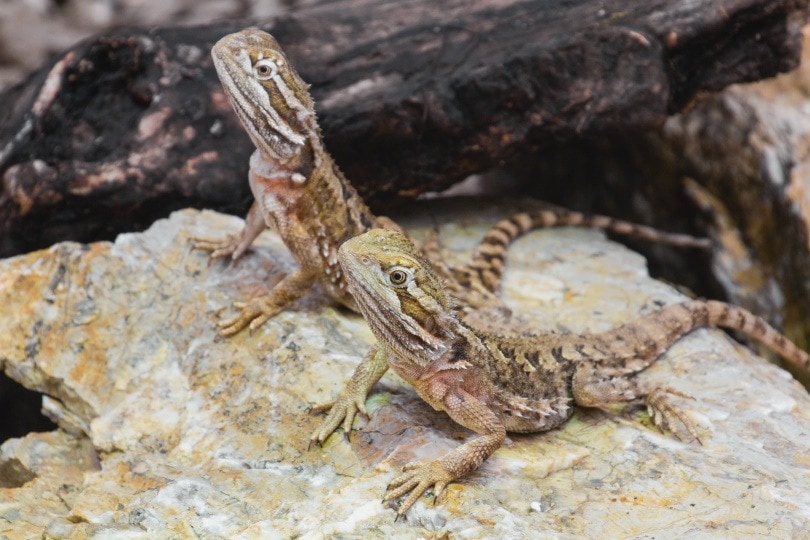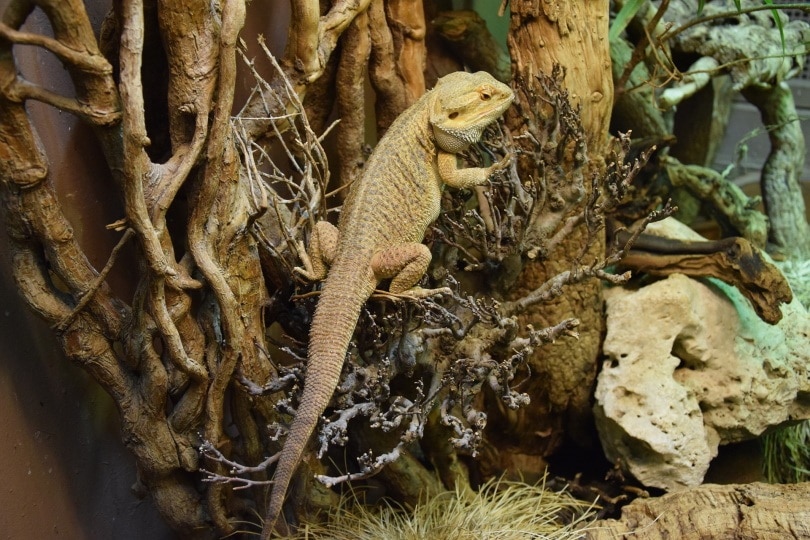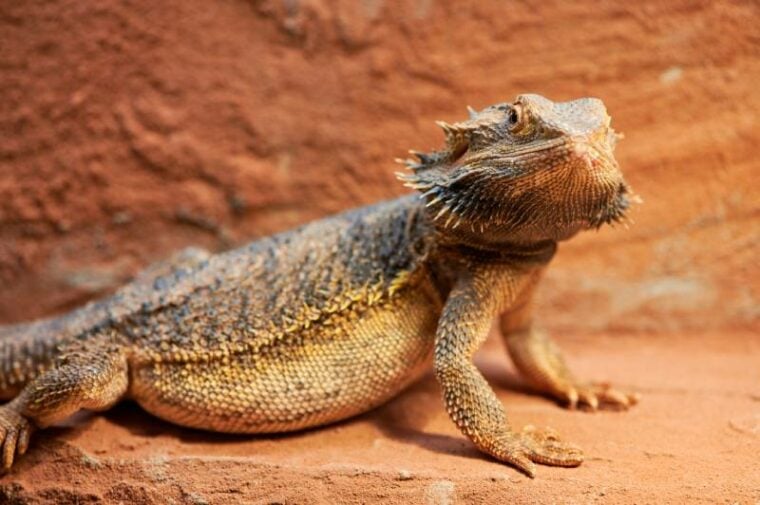
Bearded Dragons are not technically “pregnant.” They do not carry their babies inside their bodies like mammals do, as they are lizards. Therefore, they do what every other species of lizard does—lay eggs. The eggs incubate outside of their body.
However, there is a short period of 3 to 4 weeks after mating before the female lays her eggs. The female will lay many eggs all at one time, sometimes up to 30. It depends on the size and age of the female.
The eggs are incubated by their environment; the female does not sit on them as birds do. Therefore, the rate of maturation depends on the temperature and humidity of the environment. The warmer it is, the faster the babies develop inside their eggs. It usually takes between 50 to 80 days for the eggs to hatch, with the average duration being around 60 days.
Bearded Dragon Reproduction: The Basics
Bearded Dragons lay their eggs in the spring or summer months after they are exposed to colder temperatures in the winter. In the wild, Bearded Dragons experience many seasonal temperature fluctuations, so warming temperatures after a period of cold indicates spring. In captivity, this process must be artificially encouraged. Therefore, breeding can be encouraged at any time as long as the temperatures are controlled correctly.
After mating, the female will lay eggs 3–4 weeks later. The female will try to dig in their enclosure. Usually, material is provided for her to dig in, though this isn’t necessarily required. In the wild, females would dig in the sand or dirt.
The nesting area provided should be large enough for the eggs, and humid enough to encourage their proper development. It can take about 50 to 80 days for the eggs to hatch. In captivity, the eggs are often placed into a separate enclosure to prevent accidents. The temperature is often kept warm to encourage faster development.
Bearded Dragon mating is complicated and dangerous. Bearded Dragons must first go through a period of brumation brought on by colder temperatures. Brumation can be potentially deadly for all Dragons, even those in captivity.
After that, the process of mating and laying eggs can be dangerous for the female. Eggs can “get stuck” in the female’s body, causing all sorts of different problems and potentially death.
Breeding Bearded Dragons isn’t an easy job and should only be done by a professional with plenty of experience.
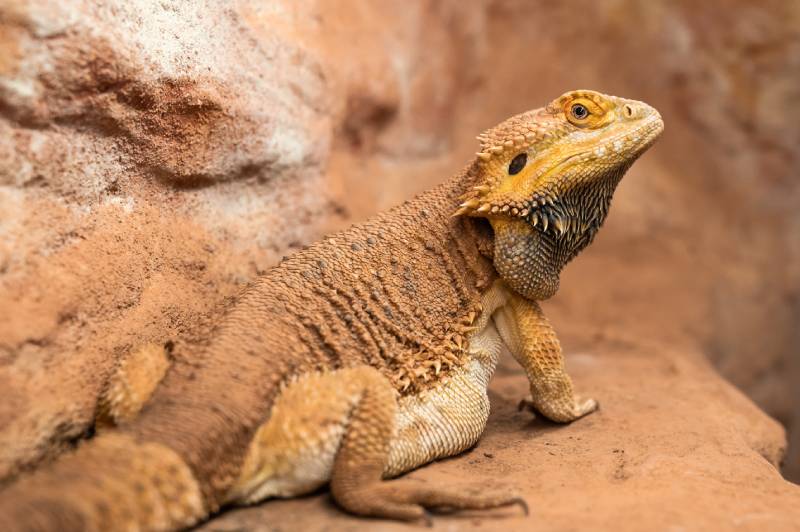
Gravid Bearded Dragons
A “pregnant” Bearded Dragon is more correctly referred to as a “gravid” Bearded Dragon. A female that becomes gravid is carrying eggs inside of her body. These eggs start developing after mating and will continue to develop for about 3–4 weeks.
When carrying eggs, female Bearded Dragons exhibit a range of changes—both physically and behaviorally. These changes may differ from dragon to dragon, and not all of these signs will be obvious all the time.
When your female is gravid, you should provide a suitable nesting area for her to lay eggs. You can use sand or soil that’s moist enough to hold its shape, but not so wet that it becomes waterlogged. Ensure that the temperature and humidity of the cage are in the right zone.
Parthenogenesis
Most female Bearded Dragons only lay eggs after mating with a male. However, this isn’t always the case. Female Bearded Dragons can also reproduce asexually without a male through a process known as parthenogenesis.
During this process, a female’s unfertilized eggs will begin to develop into embryos, even though they aren’t technically fertilized. The offspring will be exact copies of the mother, and they can develop into healthy, independent lizards under the right conditions.
In this way, a female kept in her enclosure alone can suddenly become pregnant and lay eggs that hatch.
It is important to note that parthenogenesis is relatively rare in Bearded Dragons and is not a reliable method of reproduction for breeders. Furthermore, parthenogenetic offspring may be more prone to certain genetic abnormalities, as they lack genetic diversity from a male parent.
Female Dragons can absolutely reproduce without a male partner. However, this isn’t encouraged or actively sought after.
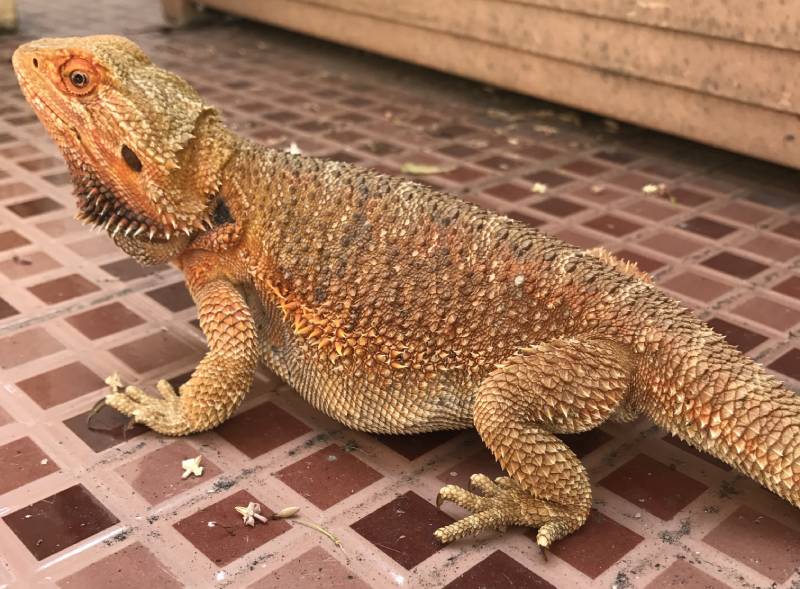
Do Bearded Dragons Lay Unfertilized Eggs?
Bearded Dragons can lay unfertilized eggs if they haven’t mated with a male during a perceived mating season. Females will begin developing eggs before they mate. If the female never mates, she is stuck with eggs that are unfertilized. These cannot stay in her body, so she lays them, even though they will never hatch.
Usually, females can lay multiple clutches of unfertilized eggs throughout a mating season. This is most common in younger females and in conditions that are favorable for egg production.
With that said, laying many sets of eggs can deplete a female’s body and lead to calcium deficiency. Therefore, it’s important to provide the female with extra care and calcium during this period. Otherwise, she may develop bone problems. Don’t forget to provide a suitable nesting period, as well. While you may know that these eggs aren’t fertile, the female doesn’t. Therefore, she will try to lay them in the perfect spot.
Laying many clutches of eggs can also be a sign of an underlying health condition or stress. Improper enclosure setups can lead to stress and may make the female spread out her clutches. Always speak to your vet if you have questions about your Bearded Dragon’s egg-laying behavior.
Conclusion
Bearded Dragons do not experience traditional pregnancy as mammals do, since they are reptiles and not mammals. Instead, they lay eggs, as is typical for all lizard species. The female Bearded Dragon undergoes a period of 3–4 weeks after mating before laying her eggs. During this period, she is called “gravid,” which is basically the reptile term for “pregnant.”
The number of eggs laid at once can range from one to 30, depending on the size and age of the female. The eggs are not incubated inside the female’s body; rather, they are laid outside and develop in the surrounding environment. The female does not sit on the eggs, as is the case with birds.
The temperature and humidity of the environment play a crucial role in the maturation rate of the eggs. Warmer temperatures generally result in faster development of the babies inside their eggs. The eggs usually take about 2 months to hatch, though certain environmental factors can postpone or postpone hatch dates.
Featured Image Credit: C. Nass, Shutterstock


